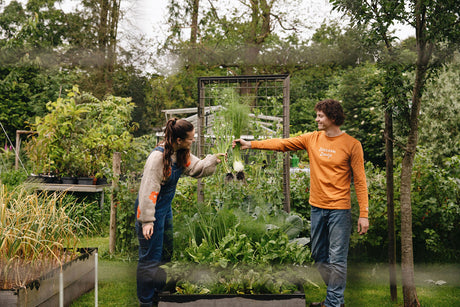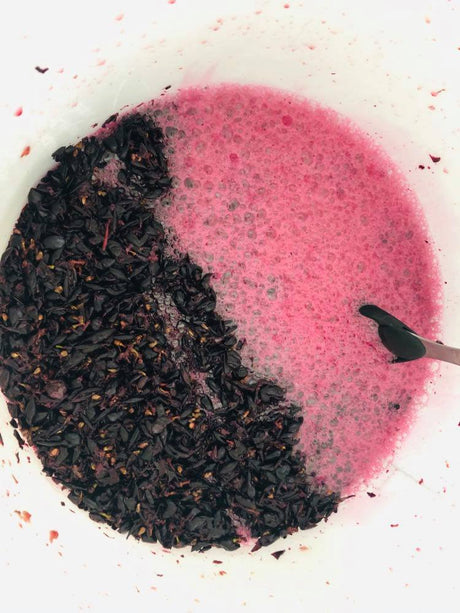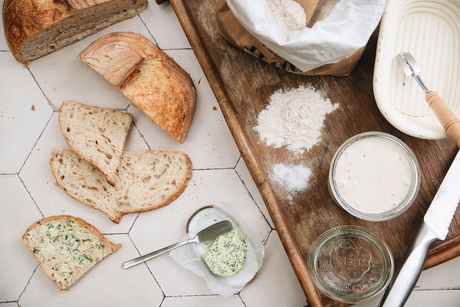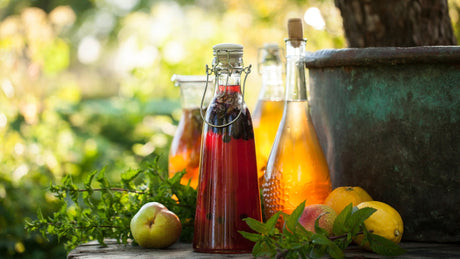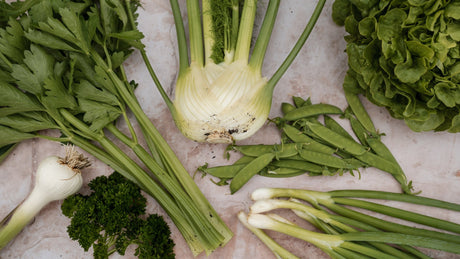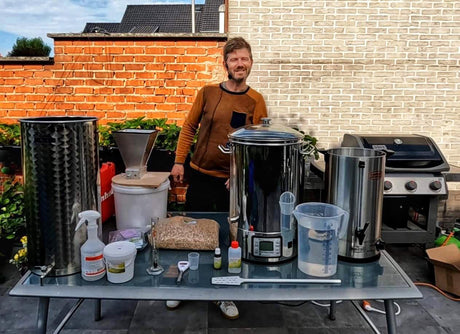Which seed tray to use: trays, containers, pots, pots, bases and under-dishes
Introduction: Why this article
I usually don't have to think long about what to write in the checklists. I glance at the latest questions in my chat or inbox, and inspiration floods in. Even on social media, I get a real pang of pain when I see some people proudly displaying their seedlings. Eight tightly packed tomato plants with hair-thin stems, crying and screaming for space and light. You've probably seen the photos too. I previously wrote an article , "Everything I know about pre-sowing ." I discussed the principles of pre-sowing, why pre-sow, water and light, and the general areas where you can pre-sow. In this article, I'll delve even deeper into what you're growing—not just pre-sowing, but also prickling out and cultivating on the patio, for example.
After preparing the trays and sowing and cutting soil, you can start sowing straight away.
What, in what to sow and how?
PART 1 - Sowing in a tray
I sow in a tray to save space . Indeed, the plant will be in a 12-liter pot on my patio. But that doesn't mean I'll sow it in a 12-liter pot right away. If I did, my house would be full. I also don't have room for 12-liter pots on my windowsill or in my own seed and cutting soil mix of 3/4 coco coir and 1/4 perlite . The tray is first filled with this soil and then with the seeds. This mix contains few nutrients, so once the seedling has taken root in the cells of the tray, I have to transplant it to richer soil. A well-controlled environment in the tray is important for seed germination. The coco coir soil does contain essential nutrients such as natural potassium and phosphorus in moderate amounts, and traces of nitrogen, calcium, magnesium, boron, chorine, iron, manganese, molybdenum, and zinc. Coconut soil is therefore very suitable for sowing and is also a renewable resource. Peat, from which regular sowing soil is made, takes too long to regrow to be considered a renewable resource.
Always 1 root ball and only seedlings in a tray
A bit of a strange title, but let me explain. Personally, I always choose to transplant the plugs from a single cell into a single root ball. I don't tear them or pry the seedlings loose. Another principle is that I always use seed-starting mix in trays and simply prick out the seedlings as soon as they transition from seedling to seedling. For most plants, this is when the second or third pair of leaves starts to grow. This is also the point at which the nutrients from the seed are depleted, and the seedlings need extra feeding.
How many seeds per tray ?
The number of seeds you sow in a tray depends on the vegetable you're sowing and whether you want to make a selection. For example, I sowed two seeds per cell with bell peppers to increase the chance of good germination. This way, I'm almost certain to have one seedling per cell. What I do then is cut off one seedling with scissors.
How many seeds per cell?
Here, it depends on how I want to plant the seedlings. With lettuce , a plant, or a zucchini, I plant one seedling at a time, aiming for one healthy seedling per cell. In that case, I also sow one seed, or if the seed variety is cheap, I sow two to keep the best and cut away the weakest. I don't use this trick with expensive F1 seeds. If I want to transplant several seedlings as a whole, like I do with parsley, flowers, lettuce, arugula, etc., I sow several seeds in a single cell. Trays with multiple cells consist of many small compartments, ideal for sowing small seeds and growing young plants. Never sow too close together in a cell; I rarely sow more than six seeds in a single cell. Experiment with different numbers as well. I now know from experience that when I plant six seeds of lettuce 10 cm apart in my winter greenhouse , it's far too close together. My Witte Dunsel lettuce was too close together last winter and took off quite quickly. Next time, I'll either sow three seeds in a cell or plant my six-seed plug 20 cm apart. It's important to understand the principle of seed spacing and planting distance.
Which type of trays for which vegetables?
The regular trays
By "regular" I mean trays measuring 51cm by 30cm and approximately 5cm deep. In our online store, they're made of hard or soft plastic and come in various diameters. A hard tray lasts much longer than a soft tray, which often develops cracks after a year. I go from largest to smallest.
trays with cells diameter +/- 5cm
I sow all the crops I want to plant out in clumps in these trays (see above). I also sow the largest seeds in this tray. However, I sow seeds larger than half a centimeter in a different way, which you'll read about later when I discuss pots. But beetroot , cucumber , gherkin, melon, etc. still go in this tray . Large pumpkin seeds, however, don't. Sometimes you'll catch me using a large one (5 cm diameter) for smaller seeds , but that might just be laziness :)
s with cells diameter +/- 4 cm
In 4cm-spaced pots, I sow seeds spaced 2-4cm apart. Spinach , lamb's lettuce , many flower varieties (unless you want them in bunches in the larger pots), tomatoes, eggplant , etc. This tray is also ideal if you only want to buy one variety; you can fit a lot in it.
trays with cells of +/- 3 cm
This is for the small seeds you want to sow individually, like lettuce, and rapeseed, which are often around 1mm. Remember that in a regular soft plastic pot, you can grow 104 seedlings (3.5 cm) in the same space as a 73-hole pot (4 cm diameter) where you can sow 73 seedlings. So be sure to choose your sowing location wisely.
The deep root trays
Not only are there low trays for shallow-rooting plants, there are also tall seed trays for deep-rooting plants. Some crops develop deep roots very quickly. When the roots reach the bottom, they can't go any further and start to circle in search of food and water, but all they find is your soil, which isn't particularly nutritious. Most plants don't appreciate this, and they get off to a bad start right from the start. Ever spent a day walking around in shoes that are too small? That's why there are deep-root trays, or trays for crops with deep roots. These tall seed trays are specially designed to provide sufficient space for deep-rooting, fast-growing plants, such as climbers and legumes. They are specifically designed to allow the root system to develop optimally. In our online store, you'll find them with 60 holes, each 4.8 cm x 4.8 cm and 12 cm deep. Here's an overview of what I use them for: peas , green beans, spring onions, onions, leeks, and broad beans.
A base for the seed trays
Because you shouldn't water every cell—with just ten or so, you'd go crazy—and also because plants naturally drink from below, it's best to water in a container where your plants are placed, also called a base. I use these two models:
-
Base 53 X 30 X 3.5cm with water drain at 1cm from the bottom - This base is perfect for all s and you can lift it a little and water it in the base.
-
Black, thick plastic Danish grow box, 56cm x 42cm x 9cm. This box is made of thick, hard plastic, and you can also use it later with your P7, P9, P11, or even your 5-liter tank, and it's easy to move. The base is a bit too sturdily for that and is only suitable for s.
PART 2 - Sowing in a seed tray
In our online store, you'll also find various sizes of s-shaped seedlings, from small to large. They're very quick to work with, faster than filling a large number of pots or a tray, for example. Many vegetable gardeners sow in a tray, just like I do, with the intention of prickling out. But because the roots of the seedlings quickly become tangled and you have to try to untangle them, I never sow in a s-shaped seedling. So, what do I use s-shaped seedlings for?
For sowing sprouts
A woman from France grows sprouts on a large scale using our seed trays. She fills them to within 0.5 cm of the rim and keeps the soil moist. She uses a small board with a handle to compact the soil, then scatters the seeds on the lightly compacted soil. The moisture from the evaporating soil is enough to germinate the seeds. On weekends, she sells the trays at the local farmers market.
For sowing crops that grow quickly and transplant very easily
In the summer, I also broadcast sow seeds for later prickling. I prefer plants that grow quickly and don't develop a large root system in that short period. Lettuce, for example, might work with cabbage varieties, and tomatoes too (although I also use broadcast sows for my tomatoes). You should experiment and see for yourself what you find easiest.
PART 3 - Transplanting young plants into pots
At certain times, it's best to prick out your young plants into the ground. It might still be too cold outside, but you can also choose to prick out your young plants into pots to protect them from birds, snails, or other creatures that love vegetables as much as we do. The goal is to let the plants grow until they're well-rooted in the pot. So make sure you time your transplanting correctly. Plants that stay in a pot too long become rootbound, or root-suffocated; plants that haven't developed enough roots are difficult to transplant.
Which pots do I use?
I use three sizes of pots for prickling. The pots are not where the seedlings mature. We've used the s and s before to save space on our windowsill, garden shed, or propagator . Prickling pots give the plants the time, nutrition, and space to grow into seedlings ready for transplanting. I choose my pots based on the size of the seedlings and how long they need to stay in the pot. I use three types of pots. I also place the plants I'm growing in them to become seedlings ready for transplanting:
P7 pots: 7 x 7 cm circumference and 8 cm deep
-
Leafy vegetables: endive, celery, arugula, lettuce, spinach , lettuce and Swiss chard
-
Cabbage crops: cauliflower , kale , broccoli , kohlrabi, red cabbage , savoy cabbage, Brussels sprouts and white cabbage (press the potting soil well)
-
Fruit crops: cucumber, cherry tomatoes, potato tomatoes and gherkins
-
Herbs: basil, dill , chervil, coriander, mint, tarragon , cilantro, sage, rosemary and parsley
P9 pots : 9 x 9 cm circumference and 10 cm deep
P11 pots: 11 x 11 cm and 12 cm deep
-
Fruit crops: pumpkin , zucchini, melon.
-
Root vegetables: Garlic
Growing strawberries in round pots
PART 4 - Which pots for which mature plant if you are not growing in open ground?
If you choose to grow your vegetables, fruit, or herbs entirely in pots , you'll need the right pot that's large enough. You can grow almost anything in pots on your patio, balcony, or flat roof. A pot must contain the soil, nutrients, and moisture needed for a plant to produce leaves, flowers, and/or fruit. The plant's roots also need sufficient space. The pot must also provide sufficient counterweight for plants that grow tall or produce heavy fruit. Growing a zucchini plant or tomatoes in a P7 pot is unlikely to be successful :) Besides a lack of root space, the plant will also starve, and the pot will crack and topple under the weight. Perhaps a fun contest for my YouTube channel? Plant a zucchini seed in a P7 pot and wait for it to topple over. Whoever is closest wins a package of vegetable garden plants . What do you think? Some plants are small enough to sow several in one pot, while others are too large and need to be planted individually. A pot should be at least 20 cm deep, and you'll need to water it two to three times a week. A pot with a saucer or a Danish tray is very useful for watering from below. Using a lid helps retain heat and moisture, so the plants grow better. Watering from above washes away the soil and isn't ideal. Below, I've listed my pot sizes for each crop:
Leafy vegetables in pots
-
lettuce : 5 liter pot (1 plant per pot)
-
lettuce , Mesclun (Asian lettuce mix), Mizuna, Rocket, ... 5 liter pot (broadcast sowing)
-
Leek : Plant 18 leek plants in a 2.5 liter pot
-
Celery: 8 litre pot (1 plant) or 40 litre pot (5 plants)
-
spinach : 8-litre pot (3 plants per pot); 40-litre pot (plant 10 plants per pot)
-
Chard / Swiss Chard: 8 litre pot (1 plant) or 40 litre pot (5 plants)
-
Sorrel: Grow in a 2.5 litre pot (sow broadcast and thinly to 6 to 8 cm)
Legumes in pots
-
peas : in a 40 litre pot, 5 cm between the peas , provide a climbing frame for the tall varieties.
-
Bush beans ( dried beans , French beans , princess beans ): 5 litre pot (2 plants per pot)
-
Princess beans: 12 litre pot (2 plants per pot)
Cabbage crops in pots
-
cauliflower : 12 litre pot (1 plant in 1 pot) or 40 litre pot (3 plants)
-
kale :
Buy seed tray and accessories
Buying a seed tray is one of those moments when you think, "Why didn't I do this sooner?" This is especially true if you regularly want to germinate seeds and grow young plants in a controlled environment. For sowing indoors, a plastic tray is ideal for regulating humidity. There are so many different types of trays available these days, from models with small cells for those delicate, tiny seeds to trays with spacious compartments perfect for large seeds. The number of cells in a seed tray determines how many plants you can grow, with more cells usually meaning smaller cells. It's helpful to think about which seeds you want to sow beforehand so you choose a tray that perfectly suits your plans. Trays with many small cells are ideal for small seeds, while large seeds like beans or pumpkins need plenty of space in larger compartments.
Accessories make working with seed trays even more enjoyable and easier. Think of a lid to maintain high humidity, so your seedlings germinate faster and more evenly. So handy! A water reservoir or saucer is also a godsend: this keeps the soil nice and moist without constantly having to water from above, and it prevents excess water from pooling. Some trays even have large holes, making it easy to remove seedlings from the tray and transplant them into the ground or a pot. This way, you don't damage the roots, and your plants continue to grow happily. Removing the lid promptly after germination promotes ventilation and prevents mold. With a seed tray, you can easily remove the seedlings from the tray, including their root ball, without damaging them.
In short, a good seed tray with the right accessories really helps you get optimal germination and strong growth from your young plants. Whether you're just starting out or an experienced vegetable grower, the right tray and accessories will make things a lot easier for you and increase your chances of a beautiful, abundant harvest. Enjoy gardening!
Professional seed trays: when and why choose pro systems?
If you really want to go big in your vegetable garden, professional seed trays are exactly what you're looking for. These handy trays are specially designed for gardeners who want to grow many seedlings at once—for example, if you want to raise vegetables, herbs, or flowers on a larger scale. They're sturdy, hard plastic trays that often have many more cells than standard ones. The trays usually have the same external dimensions, but the cells within each tray vary to ensure there's a suitable cell for every seed. This allows you to easily grow a large number of seedlings at once, without having to constantly fill new trays.
What makes these systems extra special are the smart features they incorporate. Think of a water reservoir that ensures the humidity is always optimal and your plants don't dry out quickly. There are also models with a lid, which allows you to create a kind of mini greenhouse where everything is perfect for germinating and growing your seeds. Thanks to the sturdy material, these trays will last for years, even with heavy use.
Using these types of seed trays is especially useful if you want to grow many different types of vegetables, herbs, or flowers, or if you need a large number of seedlings each year. They save you time and effort because you can fill and care for multiple cells at once. Moreover, you can easily transplant your seedlings without damaging the roots. While they cost a bit more than regular trays, these professional systems are more than worth the money for enthusiastic gardeners who want to work efficiently.
Tips and advice for using trays, containers and pots
Want to get the most out of your sowing adventure? Then we have a few handy tips that will make your life much easier. First of all, and this is really important: keep your soil nice and moist, but don't overwater. Because yes, soil that's too wet will cause your seeds to simply not germinate, or your little plants to suffer from nasty mold. That's why we always use trays with good drainage holes, or simply add a saucer – this way excess water can drain away without any hassle.
Are you going for trays with small compartments? Perfect if you want to start and grow lots of seedlings. But be careful not to cram your plants together like sardines—they need space to develop into strong, healthy seedlings. Trays with slightly larger holes are useful if you want to easily transplant them to your garden or a larger pot later. Trays with small cells are used for sowing small seeds, while trays with large cells are designed for larger seeds or fast-growing plants. When sowing, it's important to leave enough space in the cells for the seedlings to grow well, so choose seed trays that are large enough. This way, you won't damage the roots and your seedlings will continue to grow smoothly.
Feeling a bit more creative? Feel free to use old toilet paper rolls as pots – they're inexpensive, environmentally friendly, and you can just plant them right in the ground. Just make sure they're sturdy enough and don't dry out too quickly, of course. Check your seedlings regularly and give them a little water when the soil feels dry. With these tips, you'll really get the most out of your trays, containers, and pots, and give your seeds and plants the best start for a fantastic harvest!


